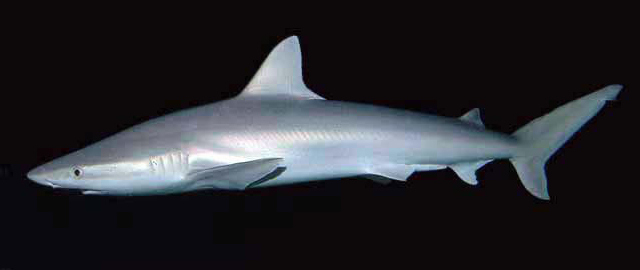Topsail Island is a stunning stretch of land off the coast of North Carolina. The island is 26 miles long, and is a barrier island, meaning that it was created by tidal action from the Atlantic Ocean that carries and deposits sand off the coast of the continent.
Over geologic time, that creates entire island chains!
Topsail Island in North Carolina is part of a chain, sitting between the Cape Fear region and the Crystal Coast barrier islands.
The closest major city is Jacksonville, though the island itself is home to the iconic Surf City. There are other communities here as well, known as Topsail Beach and North Topsail Beach.
Before you plan your next trip to Topsail (or if you’re there right now!) it might be worth asking:
Does Topsail Island, NC have sharks?

North Carolina’s beaches, including Topsail Beach, lie along a major migration route for all marine animals. Included in this popular migration route are sharks.
In fact, it’s such an important route that almost all of the shark species found along the East Coast will use this migration highway at some point during the year.
Because they’re found in the region around Topsail Island, it’s useful to know what types of sharks may show up in an encounter, and if they’re a threat.
The most common Topsail Island sharks are:
- sandbar sharks
- blacknose sharks
- hammerheads
- and spinner sharks.
Fortunately, most sharks — especially in Topsail — are not prone to attacking humans. Rather, they can actually be really interesting marine animals, and they are essential components of marine life!
Let’s learn a little bit more about the different types of sharks you might see around the waters of Topsail Island, Surf City, and more.
Types of Sharks at Topsail Island, NC
Sharks are a common concern when vacationing along ocean beaches.
But while sharks are a dangerous predator, they almost never prey on humans.
In fact, they’re largely uninterested in humans unless they’ve been provoked in some manner.
Topsail Island, along with the rest of the North Carolina coast and the eastern seaboard more broadly, is home to a large variety of shark species. Most of them are harmless to humans if treated correctly, and a handful are also environmentally protected species.
Read on to learn more about some of the species that call the waters around Topsail Island home.
Sandbar Sharks

Sandbar sharks are the most common shark along the North Carolina coast – at least of the larger species.
They spend time here year-round, unlike many other species that are only around Topsail Island during their migrations.
Usually, sandbar sharks are light gray or brown, with a long snout.
Sandbar sharks aren’t considered dangerous. Quite the opposite, in fact.
Despite their larger size, they are actually quite harmless, making them a popular choice to house in aquariums, and even to swim with!
Blacknose Sharks

Blacknose sharks are some of the smaller sharks in these waters.
They are known to spend more time close to shore than other species, sometimes traveling inland via inlets.
They’re very distinct, with a sharp black mark on the end of their noses, hence the name!
Their bodies are gray, with a slight yellow sheen.
Hammerhead Sharks

Hammerhead sharks are one of the most popular types of sharks, because of their recognizable look!
They are one of the more gentle species of shark, and are generally considered harmless to humans.
Hammerheads are a very intelligent species thanks to their large heads – they’re known to have high levels of cognition and exhibit complex relationships with social intelligence.
Hammerheads are one of the environmentally protected species found in North Carolina waters.
Carolina Spinner Sharks

Spinner sharks are an interesting species, unique for their hunting habits.
They leap out of the water by spinning, and can leap up to 20 feet above the surface of the water!
They are quite common along the Carolina coast. Despite their common presence, they’re not considered dangerous, and there have been no recorded incidents of shark attacks involving spinner sharks.
Spinners are some of the most agile sharks in the world, and they’re a popular target for sport fishing.
Shark Attack History at Topsail Island
With any ocean or coastal vacations, there’s the question of shark encounters.
While sharks themselves are quite common in the nearby waters around Topsail Island, encounters – and specifically dangerous attacks – are extremely rare.
Any kind of shark encounter, whether it’s an attack or just a bump, is really unlikely.
Despite the fears around them and the way they’re portrayed in the media, sharks don’t intentionally attack humans!
The vast majority of shark attacks are a result of a shark mistaking a person for a different animal, like its prey.
In shallow, murky waters, humans can sometimes resemble seals and other marine animals.
Sharks will occasionally nudge someone, and often if they do try out a bite, most sharks will simple let go when they realize it’s not what they were looking for.
Shark attacks are heavily overrepresented by popular media.
Sharks have been responsible for only 150 deaths in the last 500 years, fewer than the number of deaths caused by domestic dogs in just the last ten years.
While sharks do call these waters home and you may see one on your trip to Topsail Island, the chances of seeing it closely enough to cause harm are extremely slim.
So slim, that there were only 8 shark attacks recorded over an 80 year period in this region.
Avoiding Shark Attacks in Topsail Island (Tips & Things to Know)
You’ve read about some of the most common (and beloved!) Topsail Island sharks, but what do you do if you encounter one?
Most people who have spent their lives along these coastal beaches know the best tips by heart, and it’s important to read up on them before taking a vacation along North Carolina’s stunning beaches.
The right precautions can make the difference between a dangerous shark encounter and a harmless one.
Many of the things we can do to be adequately cautious in shark territory involve being aware of shark behavior – both how they interact with their environment and when they are active and present in shallow waters.
Here are some things to know to avoid a shark attack, or avoid otherwise provoking an unsuspecting shark.
First, avoid swimming when sharks are active.
Sharks are most active at night, dawn, and dusk.
More than just their activity, though, is the fact that this is their natural habitat.
Sharks can see just fine in dim light, but we cannot. Low visibility for us means that sharks can see us better than we can see them.
During the day, sharks are actually very rare.
However, even during daylight hours it’s important to exercise caution, and always look out for notices from officials and lifeguards.
Be mindful of things that attract predators.
This is both a behavioral tip and an outfit recommendation.
Excessive splashing, for example, can attract the attention of predators.
Avoid rapid motion in the water, and keep in mind that even if you are aware of this, if you have a pet with you, your pet may also contribute to splashing.
The best advice is to simply keep pets out of the water entirely.
The other half of this tip is in outfit and accessory choice.
Be mindful of anything sparkly or shiny, like jewelry or rhinestones on swimwear, as this can mimic the scales on fish. We might not be shark prey, but fish sure are!
Stay close to the shores.
Sharks don’t tend to wander too close to shore at Topsail Island simply because the water is too shallow.
However, slightly offshore, the water is just right.
If a shark is meandering close to a beach, the shallow water of the shelf is where it’s most likely to be.
More than this, the majority of crowds for beachtime recreation are either on the beach itself, or wading very close to it.
Swimming far from shore can separate you from groups, which means you’re farther from help and, as the next tip describes, more of a target.
Avoid swimming alone.
Sharks are not likely to attack or even approach groups of people, so avoid swimming alone.
This applies not just if you’ve chosen to swim a little farther from shore, but even if you’re swimming closer.
While it’s unlikely a shark will approach the shore closely, in the event that it does, it is more likely to approach a lone swimmer than a group.
Wrapping Up
Shark attacks and even minor encounters are always a frightening thought. But when swimming near Topsail Island or enjoying its many miles of beaches, shark danger is a smaller concern than many would think!
As long as you exercise caution and stay mindful of the tips to reduce the chances of a shark encounter even if there is one nearby, your vacation to North Carolina’s Topsail Island will pass just as planned.
It could even be an opportunity to learn about the biological importance of Topsail Island sharks, and how essential they are to the surrounding ecosystems!
All in all, only four of over 350 shark species worldwide are known to cause any harm to humans.
Whether you choose to swim in North Carolina or stay closer to the beaches and communities, Topsail Island is the perfect destination for a beachtime getaway.
For more, check out:
- Does Topsail Island, NC Have Jellyfish?
- Does Hilton Head, SC Have Sharks?
- Does Tybee Island, GA Have Sharks?
- Does Sanibel Island, FL Have Sharks?
Hope this helps!